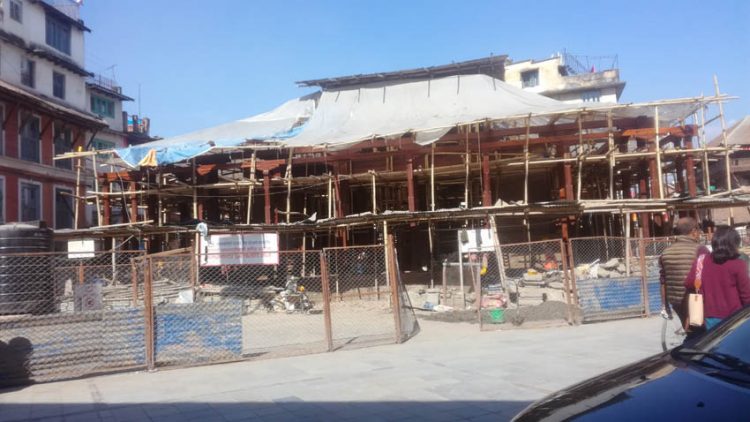Despite delays, KRC hopes to rebuild Kasthamandap within deadline
Injina Panthi / November 18, 2019

The underconstruction Kasthamandap Temple pictured on November 13. Photo: Injina Panthi/SouthAsiaCheck
The initial plan of the Kasthamandap Reconstruction Committee (KRC), the body responsible for the reconstruction of the historical Kasthamandap Temple in Kathmandu, was to complete the ground floor of the temple by June/July 2019. But even in mid-November, the work is still incomplete.
KRC Chairman Rajesh Shakya told South Asia Check that the construction work was delayed due to a shortage of Sal timber, the main construction material. Only in August 2019 that the wooden pillars of the ground floor were erected, according to Shakya.
Shakya said his committee had earlier estimated that the timber from Parsa district alone would be enough. But the timber brought from Parsa forests was found to be substandard – not good enough for Kasthamandap reconstruction. So they spent some time searching elsewhere for high-quality timber. Also the process of acquiring necessary permissions for bringing the timber took time.
Since the construction work was delayed, other peripheral work including making doors and windows and carving patterns on them could be done.
Now the KRC is working to use the timber from trees that will be felled by the Mahakali Irrigation Project in western Nepal. According to Shakya, all the necessary paperwork has been completed and tree-felling started from November 18. By December-end, the timber will arrive in Kathmandu and then work on the roof will start.
KRC hopes that if things go as planned, the construction work will be completed within the deadline. Nepal government’s policy and program document 2018/2019 states that the cultural heritage monuments destroyed by the 2015 earthquakes will be rebuilt within three years.
“A total of 12,000 cubic feet of good quality timber will be required for Kasthamandap reconstruction. The Mahakali Irrigation Project will generate around 60,000 cubic feet of timber. But if the timber from Mahakali is also found to be substandard, then we will bring the trees felled by the transmission line project in Rautahat and the road-widening project in Butwal,” said Shakya.
Besides timber, mud and bricks among other things will be needed for the reconstruction work. “Earlier, we had thought that finding right quality mud would be a problem, but now the problem has been resolved. We have already brought mud from the Dharahara [debris], Chhauni and Tahachal.” said Shakya.
The Kathmandu Metropolitan City has already provided Rs 55 million for the reconstruction work and is working to provide more.
This material is copyrighted but may be used for any purpose by giving due credit to southasiacheck.org.
Comments
Latest Stories
- In Public Interest Covid-19 cases are low, but that’s not an excuse to avoid vaccination
- In Public Interest What is BF.7, the sub-variant that has the world by its grip?
- In Public Interest Threat of a new Covid-19 wave looms large amid vaccine shortage in Nepal
- In Public Interest As cases decline, Covid-19 test centres in Kathmandu are desolate lot
- In Public Interest Dengue test fee disparity has patients wondering if they’re being cheated
- In Public Interest As dengue rages on, confusion galore about what it is and what its symptoms are. Here’s what you need to know
In Public Interest
 Covid-19 cases are low, but that’s not an excuse to avoid vaccination
The Pfizer-BioNTech bivalent vaccines authorised by the Nepal Government provide better protection a...
Read More
Covid-19 cases are low, but that’s not an excuse to avoid vaccination
The Pfizer-BioNTech bivalent vaccines authorised by the Nepal Government provide better protection a...
Read More
- What is BF.7, the sub-variant that has the world by its grip?
- Threat of a new Covid-19 wave looms large amid vaccine shortage in Nepal
- As cases decline, Covid-19 test centres in Kathmandu are desolate lot
- Dengue test fee disparity has patients wondering if they’re being cheated
- As dengue rages on, confusion galore about what it is and what its symptoms are. Here’s what you need to know